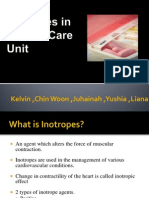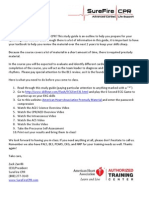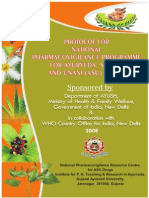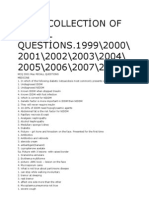100%(1)100% found this document useful (1 vote)
219 viewsCardiac Pacing
Cardiac Pacing
Uploaded by
mrygnvllThis document discusses cardiac pacing, which uses an electric device to stimulate the heart muscle and initiate contractions. It describes the clinical indications for pacing, including symptomatic bradycardia and heart block. There are different types of pacemakers including single chamber, dual chamber, and biventricular models. Pacemakers have pacing, sensing, and capture functions. The document outlines the insertion procedure and equipment needed for temporary pacing. It also discusses nursing interventions, complications, and patient education topics related to cardiac pacing.
Copyright:
© All Rights Reserved
Available Formats
Download as DOCX, PDF, TXT or read online from Scribd
Cardiac Pacing
Cardiac Pacing
Uploaded by
mrygnvll100%(1)100% found this document useful (1 vote)
219 views4 pagesThis document discusses cardiac pacing, which uses an electric device to stimulate the heart muscle and initiate contractions. It describes the clinical indications for pacing, including symptomatic bradycardia and heart block. There are different types of pacemakers including single chamber, dual chamber, and biventricular models. Pacemakers have pacing, sensing, and capture functions. The document outlines the insertion procedure and equipment needed for temporary pacing. It also discusses nursing interventions, complications, and patient education topics related to cardiac pacing.
Original Description:
Heart Medical Management
Copyright
© © All Rights Reserved
Available Formats
DOCX, PDF, TXT or read online from Scribd
Share this document
Did you find this document useful?
Is this content inappropriate?
This document discusses cardiac pacing, which uses an electric device to stimulate the heart muscle and initiate contractions. It describes the clinical indications for pacing, including symptomatic bradycardia and heart block. There are different types of pacemakers including single chamber, dual chamber, and biventricular models. Pacemakers have pacing, sensing, and capture functions. The document outlines the insertion procedure and equipment needed for temporary pacing. It also discusses nursing interventions, complications, and patient education topics related to cardiac pacing.
Copyright:
© All Rights Reserved
Available Formats
Download as DOCX, PDF, TXT or read online from Scribd
Download as docx, pdf, or txt
100%(1)100% found this document useful (1 vote)
219 views4 pagesCardiac Pacing
Cardiac Pacing
Uploaded by
mrygnvllThis document discusses cardiac pacing, which uses an electric device to stimulate the heart muscle and initiate contractions. It describes the clinical indications for pacing, including symptomatic bradycardia and heart block. There are different types of pacemakers including single chamber, dual chamber, and biventricular models. Pacemakers have pacing, sensing, and capture functions. The document outlines the insertion procedure and equipment needed for temporary pacing. It also discusses nursing interventions, complications, and patient education topics related to cardiac pacing.
Copyright:
© All Rights Reserved
Available Formats
Download as DOCX, PDF, TXT or read online from Scribd
Download as docx, pdf, or txt
You are on page 1of 4
CARDIAC PACING - It is an electric device that delivers Ability of the cardiac pace maker to see intrinsic cardiac
direct electrical stimulation to stimulate the myocardium activity when it occurs.
to depolarize ,initiating a mechanical contraction. Demand:
Clinical Indication: pacing stimulation delivered only if the heart rate
1. Symptomatic bradycardia falls below the preset limit.
2. Symptomatic heart block Fixed:
2nd degree heart block no ability to sense. constantly delivers the preset
3rd or complete heart block stimulus at preset rate.
Bifasicular or transfasicular bundle branch blocks. Triggered:
3. Prophylaxis delivers stimuli in response to (sensing) cardiac
event.
PACEMAKER DESIGN Capture function:
1. Pulse generator Ability of the pacemaker to generate a response from the
2. leads heart (contraction) after electrical stimulation.
Pulse generator 1. Electrical capture :
In permanent pacemaker is encapsulated in a indicated by P or QRS following and corresponding to a
metal can ,to protect the generator from pacemaker spike.
electromagnetic interference 2. Mechanical capture:
Temporary pacing system generator is externally palpable pulse corresponding to the electrical event.
contained in a small box
Transcutanus external pacing system house the Pacing types
generator in a piece of equipment similar to Permanent
portable ECG monitor. Temporary
Pacemaker lead biventricular
1. Single chamber (unipolar) pacemaker Types of pacing
Lead placed in atrium or ventricle 1. Permanent pacemaker
Produce large spic on the ECG Used to treat chronic heart condition
Sensing and pacing in the chamber where the lead Surgically placed transvenuosly under local
is located anesthesia
More likely to be affected by electromechanically Pulse generator placed in a pocket subcutaneously
interference ,can be adjusted externally
2. Dual-chamber (bipolar) pacemaker 2. Temporary pacemaker
One Lead located in the atrium and one in the Placed during emergencies
ventricle Indicated for pts’ high degree heart block or
Sensing and pacing in both chambers mimicking unstable bradycardia
the normal heart function Can be placed transvenously, epicardially,
Produce in visible spic in the ECG transcutanusly or transthorasicly
Less affected by electromechanical interference. 3. Biventricular pacemaker
Used in sever heart failure
Pacemaker function Utilize three leads in right atrium, right ventricle
1. Pacing function and left ventricle to coordinate ventricular
2. Sensing function coordination and improve cardiac output
3. Capture function Equipments
Transvenous pacing catheter
Atrial pacing: EKG machine
Stimulation of RT atrium produce spic on ECG preceding P Pacemaker generator with battery and cable
wave Emergency crash cart
Ventricle pacing : Lidocaine
Stimulation of RT or LT ventricle produce a spic on ECG Defibrillator
preceding QRS complex. (2) 5cc syringe with 22 and 25 gauge needles
AV pacing:
Direct stimulation of RT atrium and either ventricles mimic External Pacer
normal heart conduction Sterile gown, gloves, mask
Sensing function : INSERTION SITES
Left Subclavian (most reliable)
Internal jugular (lower incidence of 3. Monitor for evidence of lead migration and
pneumothorax) perforation of heart
Femoral vein Observe for muscle twitching and hiccups
Brachial vein Evaluate chest pain
INSERTION PROCEDURE Auscultate foe friction rub
1. Check that patient has a patent IV, and that the Observe for signs of cardiac tamponade
defibrillator, emergency cart and appropriate 4. Provide electrically safe environment
medications are available. Protect exposed parts of electrode leads with
obtain consent (time permitting). rubber
Obtain vital signs and ECG rhythm strip prior to Wear rubber gloves when touching a temporary
insertion. Connect to 12 lead EKG and pacing lead
continuously monitor before, during and after 5. Be aware of hazards in the facility that can
Anesthetize the area locally. interfere pacemaker and cause failure
Prepare the external temporary generator: Avoid use of electrical razor
Portable Chest X-ray is required to confirm Avoid direct placement of defibrillator paddles
placement. over the generator, should be placed 4-5 inches
away.
Applying transcutaneous pacing Pt’s with permanent pacemaker should never
Anterior/posterior: exposed to MRI because it may alter and erase the
Module on stand by. minimal out put program memory.
Connect pacing to external module Caution must be used if pt will receive radiation
Increase milliamp until a pacing spike and therapy.
corresponding QRS are seen. Palpate pulse 6. Prevent accidental pacemaker malfunctions
Complication Use external plastic covering over external
Movement and dislocation of the lead generator all times
Injury Secure temporary pace maker over pt’s chest or
Bleeding and hematoma wrist never hang it over iv pole
Ventricular ectopy or VT from wall stimulation Place a sign over pt's bed alerting personnel to the
Infection presence of pacemaker.
Cardiac tamponade Evaluate transecutanuse pacing every 2 hr
Nursing diagnosis Monitor for electrolyte imbalances, hypoxia and
Decreased cardiac output related to potential myocardial infarction.
pacemaker mal function
Risk for injury related to peumothorax 7. Preventing infection
Impaired physical mobility related to restriction of Take temp every 4hrs
movement. Observe for sign and symptoms of infection
Acute pain related to surgical incision or external Clean incision site with sterile technique
pacing stimuli. Monitor vein which pacing placed in for phlipaitis
Disturbed body image related to pacemaker Administer antibiotic as ordered.
implementation. 8. Relieving anxiety
Nursing intervention 9. Reliving pain.
1. Maintain adequate cardiac output 10. Maintaining a positive body image
Record information after insertion pacemaker 11. Minimizing the effect of immobility
model ,mode, program setting,pt’s rhythm Rest for 24-48 hrs post pacing insertion
Attach ECG for continues monitoring Deep breathing exercise
Analyze rhythm strips as per protocol Restrict movement of affected extremity
Monitor vital signs
Monitor urine output Patient education
Observe for dysrhythmia 1. Anatomy and physiology of the heart
2. Avoid injury 2. Pacemaker function
Obtain chest x-ray to check lead wire position 3. Activity
Monitor for sign and symptom of hemothorax Specific instruction include
Monitor for sign and symptom of pneumothorax Not to lift items over 1.4kg or perform difficult
Evaluate evidence for bleeding arm maneuver.
Avoid excessive stretching or bending excessive.
Avoid contact sport,tennis,gulfing until advised by CT Scan
doctor. Coronary Angiograph
Sexual activity can be resumed when desired
4. Pacemaker failure Coronary Angioplasty with Stents
Teach pt to check own pulse at least weekly for 1 Common treatment for Coronary Artery Disease
min Process:
Report slowing on the pulse less or greater than Blockage is defined through coronary
the setting rate angiography
Report sign and symptom as palpitation, fatigue Incision is made
,dizziness, prolonged hiccups Cardiac catheter is guided to the heart
Wear identification bracelet and carry a through an artery of the groin or arm
pacemaker identification cared. Guide wire is manipulated to
5. Electromagnetic interference lie across the blockage
Caution pt that EMI could interfere with Heparin is a given to thin the
pacemaker function. blood and prevent clotting
Explain that high energy radar, TV and radio Stent balloon catheter is transported
transmetters,MRI,large motors may affect the along the guide wire and is positioned
pacemaker function. over the blockage
Teach pt to move 4-6 m away from source and Saline is pumped into the balloon to
check pulse. it should return to normal. Most inflate it
pacemaker equipped with internal filters to Balloon is inflated for 30 to 60 seconds to
prevent interaction with cell phone. expand the stent
Tell pt that antitheft devices and airport security Stents
alarms may affect pacemaker and trigger security Expandable
alarm. Mesh-like tube
Household and kitchen appliance will not affect Invented to overcome short comings of regular
pacemaker.
coronary angioplasty
6. Care of pacemaker site.
Stays in artery permanently
Wear loose-fitting clothes around pacemaker
Kinds of Stents
Watch sign and symptom of infection
Uncoated Stents
Keep incision site clean and dry. not to scrub site
Bare metal
Advise well balanced diet.
Drug-coated Stents
Coated with Sirolimus
Controlled release of medicine into tissue
Coronary Stents
Drug limits overgrowth of natural tissue
Coronary Artery Disease - Leading cause of death in
Anti-rejection-type medicine (10% vs
United States for men and women
26%)
Caused by buildup of plaque in arteries
Pros & Cons
Heart tissue is deprived of nutrients
Pros
Risk factors:
Less invasive than open heart
Age
surgery
Gender
Short procedure
Genes
Failure rate 1%
Symptoms and Tests for Coronary Artery Disease
Cons
Symptoms:
Not a cure
Vary in strength
Aggravates kidney function
Chest pain
Stents can’t be used in every
Fatigue
surgery
Shortness of breath
Can be rejected by body
Weakness
Tests:
I WILL NOT WORRY ABOUT WHAT IS BEYOND MY
ECG
CONTROL. GOD IS FULLY IN CONTROL OF MY
Exercise Stress Test EXAMS, MY DESTINY, MY RESULTS.
Nuclear Stress Test
You might also like
- Test Questions With Answer Key - Science 9Document6 pagesTest Questions With Answer Key - Science 9Michael Deliva80% (15)
- New in ICUDocument30 pagesNew in ICUJoseAlonzoNo ratings yet
- The Piggle - An Account of The Psychoanalytic Treatment of A Little GirlEdited by Ishak RamzyDocument76 pagesThe Piggle - An Account of The Psychoanalytic Treatment of A Little GirlEdited by Ishak Ramzyupanddownfile100% (1)
- The 12-Lead Electrocardiogram for Nurses and Allied ProfessionalsFrom EverandThe 12-Lead Electrocardiogram for Nurses and Allied ProfessionalsNo ratings yet
- ECG/EKG Interpretation: An Easy Approach to Read a 12-Lead ECG and How to Diagnose and Treat ArrhythmiasFrom EverandECG/EKG Interpretation: An Easy Approach to Read a 12-Lead ECG and How to Diagnose and Treat ArrhythmiasRating: 5 out of 5 stars5/5 (3)
- Cardiac Pacing and ICDDocument74 pagesCardiac Pacing and ICDBernadixta Winda Dwi Cahyani100% (4)
- Arterial Line Arterial LineDocument13 pagesArterial Line Arterial LineLinamaria Lozano100% (1)
- This Study Resource Was Shared Via: Sinus BradycardiaDocument3 pagesThis Study Resource Was Shared Via: Sinus BradycardiaPascal St Peter NwaorguNo ratings yet
- Cardiac Surgeries: and ManagementDocument64 pagesCardiac Surgeries: and ManagementSimon Josan50% (2)
- Care For Mechanical VentilationDocument14 pagesCare For Mechanical Ventilationmaeya186135100% (3)
- Dysrhythmia Recognition Pocket Reference Card PDFDocument14 pagesDysrhythmia Recognition Pocket Reference Card PDFjenn1722100% (3)
- Arterial Lines MonitoringDocument13 pagesArterial Lines MonitoringJoseph Beredo33% (3)
- DefibrillatorDocument8 pagesDefibrillatorJisha JanardhanNo ratings yet
- PacemakerDocument48 pagesPacemakersoniya josephNo ratings yet
- Case Study On PacemakersDocument6 pagesCase Study On PacemakersBalamuruganNo ratings yet
- Pacemaker Invasive Cardiac PacingDocument57 pagesPacemaker Invasive Cardiac PacingAhmad Khalil Ahmad Al-SadiNo ratings yet
- PacemakersDocument19 pagesPacemakersAswathy RCNo ratings yet
- Defibrillator: DR Sumanth ReddyDocument39 pagesDefibrillator: DR Sumanth Reddyrohith100% (1)
- EKG Interpretation Basics Guide: Electrocardiogram Heart Rate Determination, Arrhythmia, Cardiac Dysrhythmia, Heart Block Causes, Symptoms, Identification and Medical Treatment Nursing HandbookFrom EverandEKG Interpretation Basics Guide: Electrocardiogram Heart Rate Determination, Arrhythmia, Cardiac Dysrhythmia, Heart Block Causes, Symptoms, Identification and Medical Treatment Nursing HandbookNo ratings yet
- EKG and ECG Interpretation: Learn EKG Interpretation, Rhythms, and Arrhythmia Fast!From EverandEKG and ECG Interpretation: Learn EKG Interpretation, Rhythms, and Arrhythmia Fast!No ratings yet
- Adult Cardiac Surgery - Nursing Care and ManagementDocument225 pagesAdult Cardiac Surgery - Nursing Care and ManagementOsama Elsayed AhmedNo ratings yet
- Defibrillation and Cardioversion PDFDocument12 pagesDefibrillation and Cardioversion PDFmadeNo ratings yet
- Inotropes in Critical Care UnitDocument48 pagesInotropes in Critical Care UnitKelvin Christopher Ker100% (1)
- Icu OrientationDocument9 pagesIcu OrientationKshayna 1234No ratings yet
- Critical Care - UnitDocument80 pagesCritical Care - Unitsuganthi rajesh kanna100% (1)
- 8-Hemodynamic Monitoring: Central Venous Pressure (CVP)Document6 pages8-Hemodynamic Monitoring: Central Venous Pressure (CVP)AsmaaYL100% (1)
- Temporary PacemakerDocument35 pagesTemporary Pacemakerromeorobin07No ratings yet
- Percutaneous Transluminal Coronary AngioplastyDocument22 pagesPercutaneous Transluminal Coronary AngioplastyArya Gaunker100% (1)
- Hemodynamic MonitoringDocument10 pagesHemodynamic MonitoringDivya Joy100% (1)
- Hemodynamic Monitoring For NursesDocument29 pagesHemodynamic Monitoring For NursesMahalakshmi Prabhu100% (1)
- CPR ACLS Study GuideDocument18 pagesCPR ACLS Study GuideJohn Phamacy100% (1)
- Basic Life Support (BLS) and Advanced Cardiovascular Life Support (ACLS)Document35 pagesBasic Life Support (BLS) and Advanced Cardiovascular Life Support (ACLS)rajNo ratings yet
- Swan Ganz CatheterDocument40 pagesSwan Ganz CatheterRobertson Sliva100% (3)
- Cardiac AssessmentDocument7 pagesCardiac AssessmentBryan Mae H. Degorio75% (4)
- Cardiac Catheterization and MonitoringDocument40 pagesCardiac Catheterization and MonitoringMarissa Asim100% (1)
- Hemodynamic Management Pocket Card PDFDocument8 pagesHemodynamic Management Pocket Card PDFjenn1722100% (1)
- Hemodynamics For The Bedside Nurse 1CEUDocument7 pagesHemodynamics For The Bedside Nurse 1CEURN333100% (1)
- Pacemaker NotesDocument7 pagesPacemaker Notesrohit860No ratings yet
- Cardiac Catheterization and Coronary AngiographyDocument5 pagesCardiac Catheterization and Coronary Angiographyedem100% (1)
- Ccu Survival GuideDocument10 pagesCcu Survival Guideomegasauron0gmailcom100% (2)
- ECG InterpretationDocument11 pagesECG InterpretationAndrea AndradaNo ratings yet
- Aha Guidelines StemiDocument94 pagesAha Guidelines StemiDika DekokNo ratings yet
- Unit 6 Cardiac Catheterization and AngiographyDocument28 pagesUnit 6 Cardiac Catheterization and AngiographyJack Tomar100% (1)
- Suggest Fluid Responsiveness: Pulse Pressure Variation (PPV) Cardiac Arrest UtilityDocument1 pageSuggest Fluid Responsiveness: Pulse Pressure Variation (PPV) Cardiac Arrest Utilityabobader2100% (1)
- Hemodynamic MonitoringDocument25 pagesHemodynamic MonitoringMichelle Chu100% (2)
- Cardiac Interventional Cath Lab Tech v4. Study GuideDocument2 pagesCardiac Interventional Cath Lab Tech v4. Study GuideRoric Thomas100% (1)
- Pulmonary Function TestsDocument16 pagesPulmonary Function TestsRashed ShatnawiNo ratings yet
- Cardiac CatheterizationDocument25 pagesCardiac CatheterizationQueeny Anne ApilNo ratings yet
- Basic Mechanical Ventilation 2014Document62 pagesBasic Mechanical Ventilation 2014dragon66No ratings yet
- Navodaya College of Nursing Raichur: Proforma For Registration of Subjects For DissertationDocument23 pagesNavodaya College of Nursing Raichur: Proforma For Registration of Subjects For Dissertationphibina2672No ratings yet
- SPECIFIC OBJECTIVE: On Completion of The Class StudentsDocument15 pagesSPECIFIC OBJECTIVE: On Completion of The Class Studentsanimesh pandaNo ratings yet
- DefibrillationDocument9 pagesDefibrillationWilson Tadeu Assis100% (2)
- Cardiac Dysrhythmia Final Study GuideDocument14 pagesCardiac Dysrhythmia Final Study GuideBSNNursing101100% (2)
- Ventilator Setting 10 Minutes TeachingDocument3 pagesVentilator Setting 10 Minutes TeachingAfiq Atiqullah100% (1)
- Respiratory PathophysDocument1 pageRespiratory PathophysTori IkeharaNo ratings yet
- Stress Testing & Hemodynamic Monitoring: Basic Components & SetupDocument11 pagesStress Testing & Hemodynamic Monitoring: Basic Components & SetupJack Keurig100% (1)
- Pharmacology of Inotropes and VasopressorsDocument51 pagesPharmacology of Inotropes and VasopressorsApen Silaban100% (1)
- Swan Ganz Catheterization: Prepared By: Rashmita Byanju Shrestha Nursing Incharge Sicu and HduDocument24 pagesSwan Ganz Catheterization: Prepared By: Rashmita Byanju Shrestha Nursing Incharge Sicu and HduArchana Maharjan100% (1)
- Basic Paediatric Protocol 5th Edition For PRINT 31st Oct 2022Document100 pagesBasic Paediatric Protocol 5th Edition For PRINT 31st Oct 2022Angelia WangNo ratings yet
- Historical Development of Community Health and Community Health Nursing in India and WorldDocument37 pagesHistorical Development of Community Health and Community Health Nursing in India and WorldAni mathewNo ratings yet
- Job Hazard Analysis Sample Tag Confined SpaceDocument1 pageJob Hazard Analysis Sample Tag Confined Spaceomer1980100% (1)
- Steps of An Outbreak InvestigationDocument34 pagesSteps of An Outbreak InvestigationOlivier MakengoNo ratings yet
- CEL2103 - Writing Portfolio Task 1 - Brainstorm FormDocument2 pagesCEL2103 - Writing Portfolio Task 1 - Brainstorm FormmohddartleNo ratings yet
- Atrial Fibrillation Management PDF 35109805981381 PDFDocument45 pagesAtrial Fibrillation Management PDF 35109805981381 PDFFahmi RaziNo ratings yet
- 300 20Document3 pages300 20Christian JohnsonNo ratings yet
- English UasDocument15 pagesEnglish UasNurul NurhasanahNo ratings yet
- Certificate of Concurrence: Kristin Mae-Jean M. Villaseñor, RMT, MDDocument1 pageCertificate of Concurrence: Kristin Mae-Jean M. Villaseñor, RMT, MDKristin Villaseñor-MercadoNo ratings yet
- TMAH Tetramethylammoniun Hydroxide-SDSDocument7 pagesTMAH Tetramethylammoniun Hydroxide-SDSSachin ChoudharyNo ratings yet
- Fadia Sherli Asyifa - 20210310068 - Ku 2Document1 pageFadia Sherli Asyifa - 20210310068 - Ku 2Lisa RLNo ratings yet
- Correct Mark 1.00 Out of 1.00: LocomotorDocument7 pagesCorrect Mark 1.00 Out of 1.00: Locomotorspinel sunNo ratings yet
- Pharmacovigilance Protocol For Asu DrugsDocument73 pagesPharmacovigilance Protocol For Asu DrugsAman TyagiNo ratings yet
- Virus Lytic Cycle SEDocument6 pagesVirus Lytic Cycle SEalexyswilson7No ratings yet
- Q3 Ulas Tle10 Smaw Week1Document13 pagesQ3 Ulas Tle10 Smaw Week1FERNANDO COMEDOY JRNo ratings yet
- Investigating Effect of Plant Mineral DeficienciesDocument28 pagesInvestigating Effect of Plant Mineral DeficienciesTootsie95% (20)
- Traumatic Brain InjuryDocument14 pagesTraumatic Brain InjurySamuel Hananiel RoryNo ratings yet
- Self Concept in Children and Adolescents With ADHDDocument32 pagesSelf Concept in Children and Adolescents With ADHDpsihopedcarmenNo ratings yet
- Vampire The Requiem - New DevotionsDocument6 pagesVampire The Requiem - New DevotionsGnomeMadeIon100% (3)
- Israeli Rabbi Chananya Weissman's 31 Reasons Why I Won't Take The VaccineDocument7 pagesIsraeli Rabbi Chananya Weissman's 31 Reasons Why I Won't Take The VaccinePedro VieiraNo ratings yet
- AMC Recall 1999 To 2008 (Magdi)Document243 pagesAMC Recall 1999 To 2008 (Magdi)zak67% (6)
- Notes For SMCDocument1 pageNotes For SMCNikolas PrezasNo ratings yet
- Conventional AirsprayDocument218 pagesConventional AirspraylambtranNo ratings yet
- Psychotherapy of Depression in Children and AdolescentsDocument58 pagesPsychotherapy of Depression in Children and AdolescentsYamila Borges Rivera100% (1)
- FNCP Alcohol DrinkingDocument2 pagesFNCP Alcohol DrinkingKeanu Win CatipayNo ratings yet
- 084 - 3707 - Yulia Primitasari - GalleyDocument5 pages084 - 3707 - Yulia Primitasari - GalleykarinamaliasNo ratings yet
- Tobrex Eye Drops Uses - Google Search PDFDocument1 pageTobrex Eye Drops Uses - Google Search PDFSana Faizan KhanNo ratings yet
- Safety Plan For Erection Steel BuildingDocument8 pagesSafety Plan For Erection Steel Buildingari_prasNo ratings yet

























































































